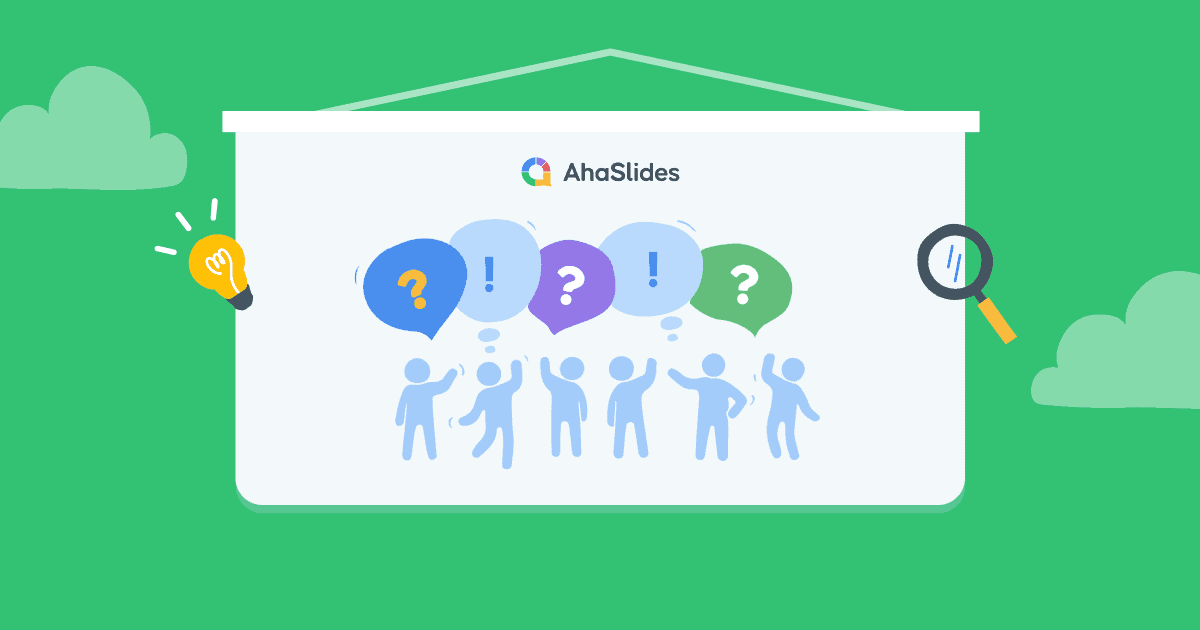"Come on guys, let's start brainstorming together!"
You’ve almost certainly heard this when you’re working with a group and most likely, you’ve responded with a groan. Brainstorm Ideas is not always a fan favorite. It can be disorganized, one-sided, and generally negative for ideas and the people suggesting them.
And yet, brainstorming sessions are so fabulously fruitful for businesses, schools and communities to grow, learn, and progress.
With these 4 steps and tips, you’ll be running brainstorming sessions that get brains truly storming with inspiration and concepts.
So, let’s learn more tips and tricks for brainstorming ideas with the help of AhaSlides!
Table of Contents
- Brainstorm Ideas Meaning
- Step #1 - Ice Breakers
- Step #2 - Lay out the Problem Clearly
- Step #3 - Set up and Ideate
- Step #4 - Refine to Perfection
- Extra Tips to Brainstorm Ideas
- Brainstorming Ideas for Business
- Brainstorm Ideas for School
- Frequently Asked Questions
Overview
| What is a technique for brainstorming new ideas by asking a lot of questions? | Starbusting |
| What method is not good for a group brainstorm? | Formulation of the hypothesis |
| Who invented the brainstorm word? | Alex F. Osborn |
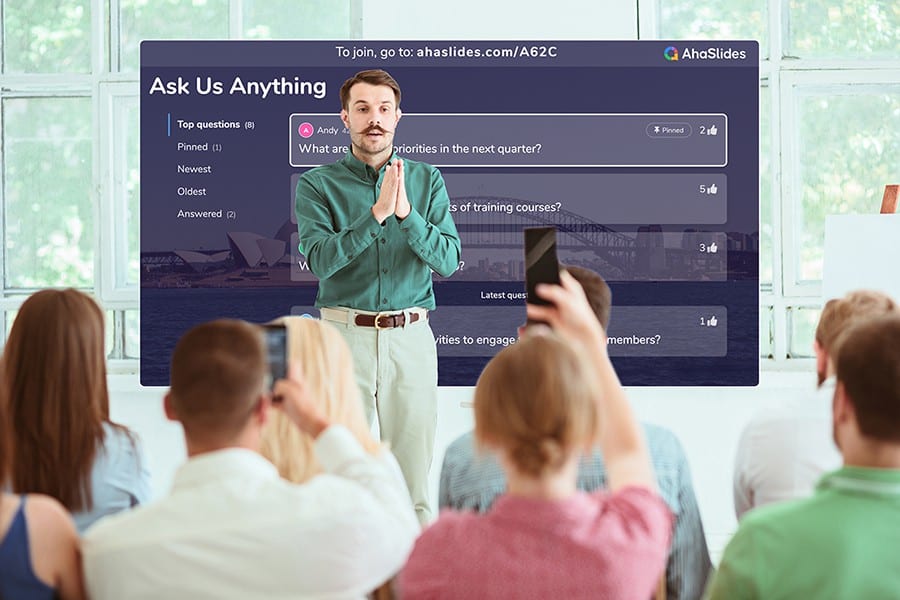
Need new ways to brainstorm?
Use fun quiz on AhaSlides to generate more ideas at work, in class or during gatherings with friends!
🚀 Sign Up For Free☁️
What ‘Brainstorm Ideas’ Means
Let’s start with the basics (that are often misunderstood).
In its most simple form, brainstorming ideas is when a group of people come up with multiple ideas to an open-ended question. It usually goes something like this…
- A question is posed to a big group, several small groups or a room of individuals.
- Each participant thinks of an idea in response to a question.
- Ideas are visualized in some way (maybe through a spider-like mind map or simple Post-it notes on a board).
- The best ideas amongst the bunch are chosen by vote.
- Those ideas progress to the next round where they’re discussed and refined until perfect.
You can brainstorm ideas in any sort of collaborative environment, such as at work, classroom, and community. Additionally, it is helpful for outlining ideas when writing essays or stories, and conceptualizing plans for other creative projects.
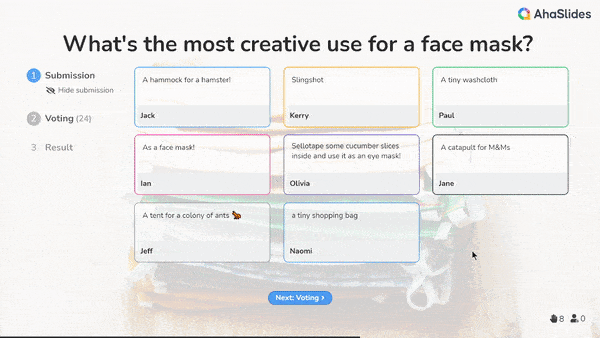
Host a Live Brainstorm Session for Free!
AhaSlides lets anyone contribute ideas from anywhere. Your audience can respond to your question on their phones then vote for their favourite ideas! Follow these steps to facilitate a brainstorming session effectively.
Step 1: Start with an Ice Breaker
It feels like we’re constantly breaking ice nowadays. If it’s not the collapse of arctic environments, it’s endlessly sitting in team meetings, catching up with colleagues for a brief period.
Ice-breakers are sometimes hard to come up with, but they can be incredibly effective in breaking down barriers and setting a comfortable tone when brainstorming. Creating a fun, friendly, and cooperative environment through ice breakers can increase the quantity and quality of brainstorming ideas, as well as help participants build rapport and empower each other’s ideas.
There’s one virtual ice-breaker activity in particular that can generate a lot more quality in a brainstorming session. It involves sharing embarrassing stories with each other.
Research from Harvard Business Review shows that some teams were instructed to share embarrassing stories with each other before brainstorming. Other teams launched right into the brainstorming session.
We found that the “embarrassment” teams generated 26% more ideas spanning 15% more use categories than their counterparts.
Harvard Business Review
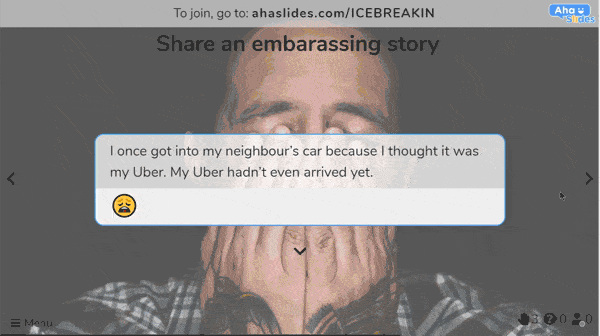
As the lead researcher, Leigh Thompson put it, “Candor led to greater creativity.” Opening up to judgment before the brainstorming session meant that there was less fear of judgment when the session began.
Some simple icebreakers to run before a brainstorming session:
- Desert Island Inventory – Ask everyone what 3 items they would take with them if they’ll be dropped and isolated on a desert island for a year.
- 21 questions – One person thinks of a celebrity and everyone else has to find out who it is by only asking 21 questions or less.
- 2 truths, 1 lie – One person tells 3 stories; 2 are true, 1 is a lie. Everyone else works together to guess which is the lie.
- Online Quiz Creator – A 10-minute team quiz can be just the ticket for releasing stress and priming minds for collaboration
💡 Need a free quiz? You’ll find loads of choices in AhaSlides’ interactive quiz template library.
Step 2: Lay out the Problem Clearly
One of Einstein’s favorite quotes was this: “If I had an hour to solve a problem, I’d spend 55 minutes defining the problem and 5 minutes thinking about solutions.” The message rings true, especially in today's fast-paced world, where people often rush to find quick solutions without fully understanding the problem at hand.
The way you phrase your problem has a huge impact on the ideas that come out of your brainstorming session. The facilitator may be put under pressure, but there are a few best practices to make sure you’re kicking things off right.
Here’s one: be specific. Don’t give your team a lazy, generalized problem and expect them to come up with the perfect solution.
Instead of: “What can we do to increase our sales?”
Try: “How should we focus on social channels to maximize our revenue?”
Giving teams a clear starting point (in this case, channels) and asking them to work towards a clear end point (maximize our revenue) helps them formulate the path with great ideas.
You can even move away from the question format entirely. Try approaching problems from the users’ perspective with their personal story, which compacts all the information necessary for the problem into one simple sentence.

Instead of: “What feature should we develop next?”
Try: “As a user, I want [a feature], because [a reason]”
Doing things this way means you can come up with a lot more mind maps, but each one will be quicker to make and much more detailed than the alternative.
As what Atlassian has stated, this method of brainstorming focuses on the users’ preferences; therefore, it is easier to come up with creative ideas to address their concerns and needs.
Step 3: Set up and Ideate
You may have heard of Jeff Bezos’ two-pizza rule. It’s the one he uses when he’s brainstorming ways to waste more billions on ostentatious rockets to nowhere.
If not, the rule states that the only people who should be present in a meeting should be able to be fed two pizzas. More people than that increases the chance of ‘groupthink,’ which can cause problems like unbalanced conversations and people anchoring onto the first few ideas that were brought up.
To give everyone a voice in your brainstorming session, you can try one of the following methods:
- Small teams – Set up teams of 3 to 8 people. Each team heads off to a different corner of the room, or a breakout room if you’re hosting a virtual brainstorm, and then generate some ideas. After a certain amount of time, you call all the teams together to summarize and discuss their ideas and add them to a collaborative mind map.
- Group Passing Technique (GPT) – Gather everyone in a circle and ask each one to write one idea on a piece of paper. The paper will be passed on to everyone in the room and the task is to contribute an idea based on what’s written on the paper. The activity stops when the paper is handed back to the owner. Through this, everyone can receive fresh perspectives and expanded concepts from the group.
Nominal Group Technique (NGT) – Ask everyone to brainstorm ideas individually and allow them to remain anonymous. Each person must submit an idea, and then the team will vote for the best forwarded suggestions. The most voted ones will be the springboard for in-depth discussions.
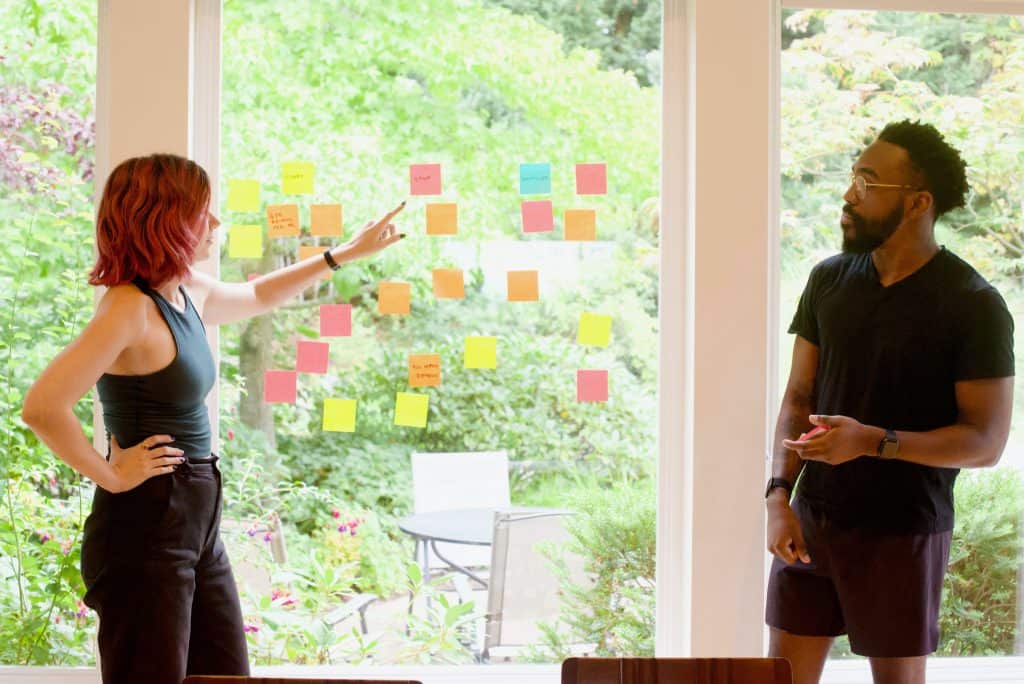
💡 Try the Nominal Group Technique – Create anonymous brainstorms and voting sessions with this free interactive tool!
Step 4: Refine to Perfection
With all ideas in the bag, you’re set for the final step – voting!
First, lay out all the ideas visually, so it becomes easily digestible. You can present it with a mind map or by grouping the papers or post-it notes which share the same idea.
After organizing each person’s contribution, relay the question and read each idea aloud. Remind everyone to take into account the vital aspects of whittling down ideas to the best possible group:
- An idea must be cost-effective, both in terms of financial cost and cost of man hours.
- An idea must be relatively easy to deploy.
- An idea must be based on data.
SWOT analysis (strengths, weaknesses, opportunities, threats) is a good framework to use when picking the best of the best. Starbursting is another one, in which participants answer the who, what, where, when, why and how of each idea.
Once everyone’s clear on the idea framework, elicit the votes. This can be through dot voting, secret ballot, or a simple raise of hands.
👊 Protip: Anonymity is a powerful tool when it comes to brainstorming and idea voting. Personal relationships can often tilt brainstorming sessions in favor of less well-rounded ideas (especially at school). Having each participant submit and vote for ideas anonymously can help cancel that out.
After voting, you’ve got a handful of fantastic ideas that need a bit of polishing. Hand the ideas back to the group (or to each small team) and build upon each suggestion through another collaborative activity.
There’s no doubt that before the day ends, you can bag yourself one or more killer ideas that the whole group can feel proud of!

AhaSlides’ Free Brainstorm Ideas Template For Free!
Keep up with the modern times and use AhaSlides, a free software that transforms tedious brainstorming sessions into a fun and engaging activity!
Get Started for Free
Extra Tips to Effectively Brainstorm Ideas
The best brainstorming sessions are those that encourage open and free-flowing discussions among team members. By creating a relaxed and non-judgmental environment, participants feel more comfortable sharing their ideas, no matter how unconventional or out-of-the-box they may be.
These are some brainstorming techniques that you may follow to improve your brainstorming sessions with your colleagues and class:
- Make everyone feel heard – In any group, there are always expressive and reserved people. To make sure that even the quiet ones have their say, you can use a free interactive tool, such as AhaSlides that lets everyone contribute an idea and vote for what they deem relevant. Orderly brainstorming is always productive.
- Ban the boss – If you’re the one running the brainstorming activity, you’ll need to take a backseat when it starts. Authority figures can cast an unintended cloud of judgment, no matter how well-liked they are. Just pose the question then put your trust in the minds in front of you.
- Go for quantity – Encouraging the bad and the wild may not sound productive, but it’s actually a way to get all the ideas out. This creates an environment where judgment is expelled and every idea is valued. This approach can lead to unexpected connections and insights that may not have been discovered otherwise. Furthermore, encouraging quantity over quality helps to prevent self-censorship and allows for a more comprehensive exploration of potential solutions.
No negativity – Restricting negativity, in any case, can only be a positive experience. Make sure no one is shouting down ideas or critiquing them too much. Instead of responding to ideas with “no, but…”, encourage people to say “yes, and…”.
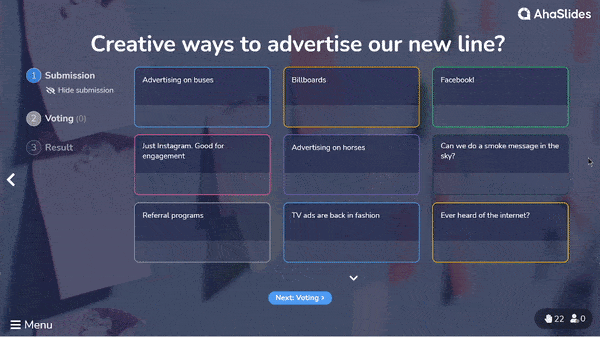
Brainstorm Ideas for Business and Work
Brainstorm facilitation at work? It goes without saying that businesses have realized the importance of effective brainstorming sessions in order to foster innovation and problem-solving. Here are some questions to ask your team to guide them into producing the best ideas when brainstorming:
- “What 3 items would you like to have to get off a desert island?”
A classic ice breaker question to get minds whirring. - “What is the ideal customer persona for our newest product?”
A great base to launch any new product. - “Which channels should we focus on in the next quarter?”
A nice way to get a consensus on the marketing plan. - “If we want to head into the realms of VR, how should we do it?”
A more creative brainstorm idea to get minds flowing. - “How should we set out our pricing structure?”
A prime factor of every business. - “What’s the best way to increase our client retention rate?”
A good discussion with a lot of potential ideas. - What position do we need to hire for next and why?
Let the employees choose!
Brainstorm Ideas for School
There’s nothing quite like a brainstorming activity for students to fire up young minds. Check these examples of brainstorming for the classroom 🎊
- “What’s the best way to get to school?”
A creative brainstorm idea for students to discuss the pros and cons of different transport methods. - “What should we do for our next school play?”
To gather ideas for a school play and vote on the favorite. - “What’s the most creative use for a face mask?”
A great ice breaker to get students thinking outside the box. - “What was the best role to have in WWII and why?”
A great way to teach and gather ideas about alternative jobs in the war. - “What chemicals make the best reaction when mixed?”
An engaging question for advanced chemistry class. - “How should we measure the success of a country?”
A good way to get students thinking outside of GDP. - How do we decrease the level of plastic in our oceans?
A poignant question for the next generation.
Brainstorming allows for a diverse range of perspectives to be explored, leading to innovative solutions and creative breakthroughs. Additionally, incorporating visual aids, such as mind maps or grouping similar ideas on post-it notes can help to visually organize the brainstorming session and make it more efficient. Visual organization can help participants see connections and patterns between ideas, leading to an even more innovative and creative way of thinking.
Good thing that there's free online software, such as AhaSlides to make the brainstorming process interactive and stimulating. Word Clouds and Live Polls allow participants to actively contribute their ideas and vote on the most promising ones.
Say goodbye to traditional, static brainstorming methods, and embrace a more dynamic and interactive approach with AhaSlides.
Try AhaSlides today and experience a new level of collaboration and engagement during your brainstorming sessions!
🏫 Get these questions in our brainstorm ideas for school template!
Frequently Asked Questions
Simple Icebreakers to Run before Brainstorming Session
(1) Desert Island inventory - Ask everyone what 3 items they would take if dropped on a desert island for a year. (2) 21 questions - One person thinks of a celebrity and everyone else has to find out who it is in 21 questions or less. (3) 2 truths, 1 lie - One person tells 3 stories; 2 are true, 1 is a lie. Everyone else works together to guess which is the lie.
Extra Tips to Effectively Brainstorm Ideas
You should try (1) hear everyone, (2) leave the boss out of the meeting, so people feel more comfortable to speak, (3) Gather as many opinions as possible (4) Positive vibe with no negativity
What are the questions to ask when brainstorming at school?
What's the best way to get to school?
What should we do for our next school play?
What's the most creative use for a face mask?
